Implementing Robotic Process Automation in Banking? [2025 Guide]

Banks are under pressure to handle massive data, strict regulations, and rising customer expectations. Robotic process automation in banking helps solve these challenges by automating repetitive workflows and improving accuracy across operations. This MOR Software’s guide explores how financial institutions can adopt RPA to streamline compliance, boost efficiency, and stay competitive in 2025.
What Is Robotic Process Automation In Banking?
Robotic process automation in banking uses software bots to carry out repetitive, rule-based digital tasks much like a human employee. These bots interact with existing systems to move data, update information, verify documents, and complete structured workflows with high accuracy. They can log into applications, copy and paste data, compare entries, and process transactions across multiple platforms, allowing teams to focus on more strategic work. McKinsey estimate that machines could perform 10 to 25% of work across bank functions, which is why these bots excel at routine, high-volume tasks.
In the RPA in banking model, bots act as digital assistants across the front, middle, and back offices. They handle a wide range of functions, from customer onboarding and compliance checks to account reconciliation and data management. This setup allows banks to maintain consistency, speed, and accuracy even with large volumes of daily operations.
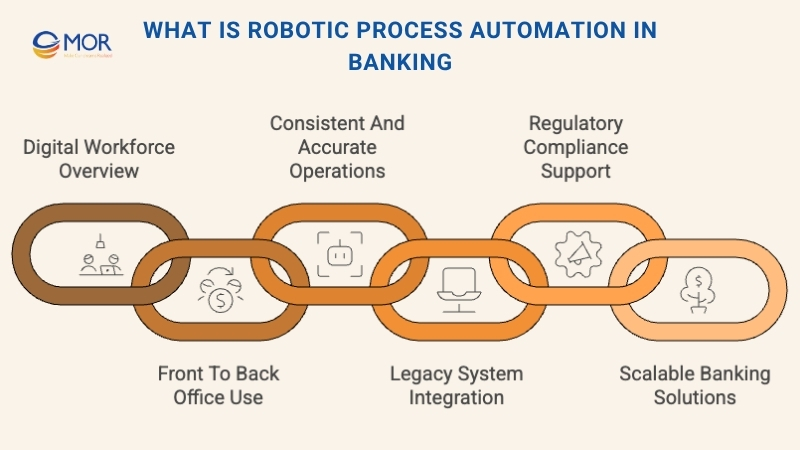
When adopting this technology, financial institutions can better manage complexity and meet strict regulatory standards. The technology supports integration with legacy systems that are still essential to operations while improving scalability and reducing manual errors. In essence, robotics process automation in banking transforms how institutions manage tasks, data, and compliance, driving efficiency across the entire organization.
>>> Explore how strong cloud data governance in the cloud ensures transparency, reduces risks, and supports smarter decision-making for long-term business growth.
How Does Robotic Process Automation In Banking Work?
Robotic process automation in banking operates through a network of software bots programmed to perform routine, rule-based activities without direct human input. These bots complete structured tasks like data entry, validation, and reporting by following preset workflows. The approach enables faster and more accurate execution of daily banking processes, reducing delays and manual errors.
The setup begins with identifying functions that rely heavily on repetitive actions or structured information, such as account reconciliation, loan processing, or customer onboarding. Once these operations are selected, each action is mapped so the bot can imitate human behavior, logging into systems, pulling records, verifying data, and updating multiple platforms in real time.

During implementation, bots connect to various systems through APIs or direct user interfaces depending on the software’s compatibility. For instance, a bot might retrieve client information from a core platform, match it with compliance databases, and automatically update customer profiles. This method allows RPA automation in banking to streamline workflow automation and minimize processing time.
Banks supervise their digital workforce through control dashboards that track performance and flag exceptions. When errors or incomplete records appear, the bot sends alerts for manual review. Over time, these systems learn from operational data, improving speed and accuracy. In this way, robotics process automation in banking serves as a reliable digital partner, strengthening productivity while employees focus on analytical and customer-centered responsibilities.
Why Is Robotic Process Automation Important In Banking
Bank staff manage an enormous flow of customer data every day, and manual handling often increases the risk of mistakes. Repetitive tasks such as data entry, validation, and reconciliation leave room for errors that can cause issues like fraud or compliance failures. In contrast, robotic process automation in banking eliminates this vulnerability by executing these actions consistently and accurately, reducing operational risks.
Instead of employees manually verifying and transferring information, bots process it within seconds. They can validate customer details across multiple databases far faster than humans, keeping accuracy high and processing costs low. Many financial institutions using robotic automation in financial services have seen operating expenses drop by as much as 30–70%, while also improving turnaround times for transactions and reporting.
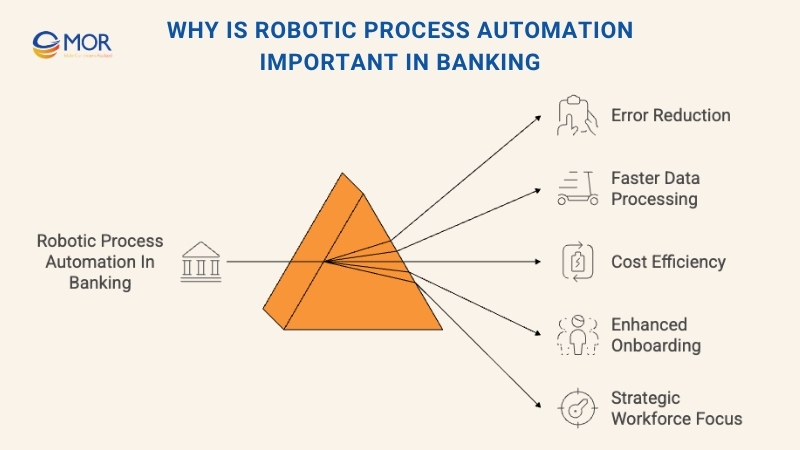
Take customer onboarding as an example. Traditionally, it required gathering documents, confirming identities, and manually entering information across systems. Through automation, a bot can extract data from digital forms, cross-check it against regulatory databases, and update core banking systems automatically. The process is faster, more reliable, and supports compliance.
Applying RPA in banking, organizations not only cut costs but also allow their teams to concentrate on strategy, customer relationships, and innovation. This balance of precision and productivity shows why automation has become indispensable to modern financial operations.
What Are Benefits Of Robotic Process Automation In Banking
The benefits of robotic process automation in banking extend far beyond cost savings. It improves accuracy, scalability, compliance, and customer experience, giving financial institutions stronger control over daily operations and long-term growth. Let’s explore the most notable advantages that modern banks achieve through this technology powered by banking process automation software.
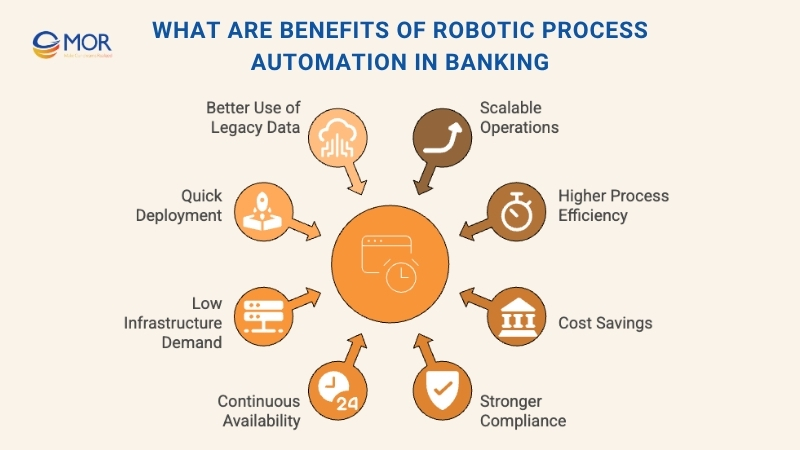
Scalable Operations
Bots can handle large workloads effortlessly. When transaction volumes rise, additional digital workers can be deployed within minutes to manage demand. This scalability ensures banks stay responsive during peak hours while freeing employees to focus on innovation and business development.
In a global Deloitte survey, leaders expected robots to provide about 20% of FTE capacity on average, and organizations already scaling targeted as high as 52%. This shows why capacity can be dialed up quickly.
Higher Process Efficiency
Once properly configured, automation boosts speed and consistency. Tasks that once took hours now finish in minutes, improving productivity and turnaround times across departments.
A famous example comes from CIMB, which reported up to a 90% reduction in turnaround times after deploying RPA in back-office tasks.
Cost Savings
With reduced manual involvement, institutions can cut processing expenses by 25–50%. The shift to robotic process automation in banking helps teams accomplish more with fewer resources, ensuring financial sustainability.
EY has documented cost reductions of 50 to 70% in some accounting and finance activities when the processes are well suited to automation. This is what best-in-class programs can achieve.
Stronger Compliance and Reporting
Automated workflows create full audit trails for every action. This transparency lowers compliance risks and simplifies regulatory reporting, supporting better governance. IBM notes that RPA can provide a clear audit trail while enforcing rule-based steps, which improves accuracy and speeds up reviews.
Continuous Availability
Unlike human staff, bots work nonstop. Their 24/7 performance guarantees consistent accuracy and uninterrupted service delivery, even outside business hours. During the pandemic, nearly 60% of service firms said RPA helped them keep business processes running smoothly when staffing was limited, showing how dependable automation can be in tough times.
Low Infrastructure Demand
A key advantage of robotic automation in financial services is its compatibility with existing systems. Since bots operate through existing interfaces, infrastructure changes are minimal, especially with cloud-based deployment options.
Quick Deployment
Modern AI automation tools use drag-and-drop functions that allow rapid setup without complex coding. Banks can launch, test, and scale new workflows within days, not months.
For example, Forrester’s Total Economic Impact analysis of a composite enterprise using Microsoft Power Automate calculated a 248% ROI with payback in under six months. This shows how quickly well-scoped automations can prove out.
Better Use of Legacy Data
Through intelligent data integration, automation connects old and new systems seamlessly. This enables teams to unify records, generate insights faster, and make informed decisions that fuel steady business growth.
One real-world example from Accenture showed that when a bank automated its KYC process, case-processing time dropped by 15% while review quality improved. This proves that better data flow can truly speed up decision-making.
Manual Processes Vs. Robotic Process Automation In Banking
Manual processes in banking often lead to slow operations, higher costs, and frequent human errors. Introducing robotic process automation in banking, institutions can streamline repetitive tasks, accelerate turnaround times, and maintain greater accuracy. The comparison below shows how automation outperforms traditional methods across key banking activities.
Process | Manual Banking | With Robotic Process Automation in Banking | Benefit |
| Account Opening | 25–30 minutes with repeated data input across systems | 3–5 minutes with automated validation and form filling | Faster onboarding and greater accuracy |
| Credit Card Processing | 7–10 days to verify documents and credit history | Less than 24 hours through automated background checks | Improved customer experience and faster turnaround |
| KYC Verification | 2–3 hours of document inspection by staff | Under 10 minutes with bots performing instant cross-checks | Higher compliance accuracy and reduced operational cost |
| Mortgage Loan Approval | 50–53 days due to manual verification and approvals | Completed within hours through automated workflows | Quicker loan disbursement and lower default risk |
| Fraud Detection | Manual review struggles with high transaction volumes | Real-time monitoring using AI integrated with robotics in banking | Stronger protection and proactive risk control |
| Report Preparation | Error-prone manual compilation of financial data | Automated report generation in minutes with verified accuracy | Improved trust and regulatory compliance |
| Customer Queries | Long wait times via phone or email support | Real-time responses from chatbots and digital assistants | 24/7 personalized customer service |
Top Use Cases Of Robotic Process Automation In Banking
Robotic process automation in banking has become a key driver for improving efficiency across financial operations. In the banking sector, it automates repetitive and rule-based processes, freeing staff to focus on customer engagement, innovation, and compliance oversight. Let’s look at one of the most common applications where automation delivers measurable results.
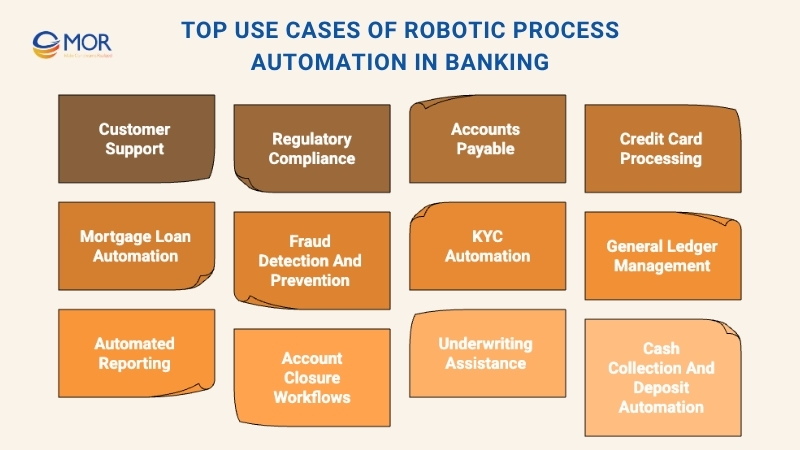
Customer Support Automation
Banks handle thousands of daily customer requests, from balance checks and account updates to loan application tracking. Managing this volume manually often leads to delays and long response times. That’s where robotic process automation examples in banking make a real difference.
With bots integrated into customer service systems, queries can be handled instantly. These digital assistants access data in real time, answer frequently asked questions, and even process routine requests within seconds. When combined with AI and natural language processing tools, RPA in banking enables chatbots to interpret customer intent and respond conversationally, improving satisfaction and reducing workload on human agents.
Through robotic process automation in retail banking, institutions deliver faster support, minimize operational costs, and maintain a consistent service quality around the clock, something traditional call centers rarely achieve.
Regulatory Compliance
Since the financial system operates under strict oversight, ensuring adherence to legal and industry standards is non-negotiable. Automating compliance processes through robotic process automation in banking helps institutions maintain accuracy and transparency while reducing manual workloads. In fact, many experts recognize automation as a strong enabler for improved governance and faster reporting.
Using bots, banks can track every transaction, verify documentation, and generate audit-ready reports around the clock. This approach reduces the chance of human oversight and ensures consistent alignment with regulatory frameworks. As a result, robotic process automation use cases in banking are becoming central to risk management and operational integrity.
Accounts Payable Automation
The accounts payable function often involves repetitive steps such as reading invoices, validating vendor details, and releasing payments. While essential, this task consumes valuable time that could be directed toward higher-value activities. With RPA automation in banking, these workflows can be streamlined effortlessly.
Using OCR technology, bots can extract data from scanned or digital invoices, verify the details against internal databases, and initiate payments automatically. In case of mismatches, the system alerts staff for review. This form of automation for banking not only speeds up processing but also improves accuracy, enabling finance teams to maintain stronger control over cash flow and vendor relationships.
Credit Card Processing
In traditional banking workflows, reviewing and approving a credit card application could take weeks. Staff had to manually validate customer details, review documents, and perform background and credit checks, leading to delays and higher operational costs. With robotic process automation in banking, these tasks are now completed within hours.
Bots interact with several internal and external systems simultaneously to collect and verify customer data, assess eligibility, and make rule-based decisions on approval or rejection. This automation improves processing speed, enhances compliance, and delivers a smoother experience for customers applying for credit cards.
Mortgage Loan Automation
Mortgage approvals are among the most time-consuming processes in the financial industry, often taking over 50 days to finalize in some markets. Each application requires multiple verifications, including credit score analysis, employment confirmation, and document validation. Through robotic process automation in lending, banks can drastically cut this timeline.
Automated workflows handle the necessary verifications quickly, detect missing details, and flag potential issues for human review. This minimizes bottlenecks and shortens approval cycles from weeks to just a few hours. By digitizing and accelerating these steps, robotics process automation in banking helps institutions serve customers faster while maintaining accuracy and compliance in every loan decision.
Fraud Detection and Prevention
As banking becomes increasingly digital, fraud detection has become a top priority. Monitoring thousands of transactions manually in real time is nearly impossible, leaving room for suspicious activity to go unnoticed. Through robotic process automation in banking, institutions can identify irregular patterns instantly and flag high-risk transactions before damage occurs.
Bots can analyze transaction data, compare it against predefined risk rules, and alert compliance teams within seconds. In more advanced setups, automation combined with machine learning enables systems to block suspicious accounts or freeze questionable activities automatically. This proactive approach strengthens security, helping banks maintain customer trust while reducing financial losses.
KYC Automation
The Know Your Customer (KYC) process is essential for verifying client identities and preventing illegal activities like money laundering or fraud. Traditionally, banks dedicate hundreds of employees to handle these checks, resulting in high operational costs and long turnaround times. By implementing robotic process automation in banking industry operations, institutions can streamline KYC verification with precision and speed.
Bots automatically extract and validate customer information from multiple databases, confirm document authenticity, and update records with minimal manual input. This automation cuts compliance costs significantly, improves data accuracy, and ensures that every customer’s profile meets regulatory standards. With RPA in banking, KYC becomes faster, more reliable, and far less resource-intensive.
General Ledger Management
Maintaining an accurate general ledger is critical for any financial institution. It records assets, liabilities, revenues, and expenses that shape the bank’s financial statements. Errors in these reports can damage credibility with investors, regulators, and the public. However, because data is often scattered across multiple legacy systems that don’t easily connect, manual updates are slow and prone to mistakes.
Robotic process automation in banking solves this challenge by consolidating information from various platforms, regardless of format or technology. Bots collect, verify, and organize financial data automatically, ensuring the ledger remains accurate and up to date. By integrating seamlessly with older systems, automation minimizes human error, speeds up reconciliation, and provides real-time visibility into financial records.
Automated Reporting
Accurate reporting is another essential responsibility for financial institutions. From regulatory submissions to internal performance summaries, every report must be precise and delivered on time. Traditionally, preparing these reports involves gathering data manually, which increases the risk of inconsistencies.
With robotics in banking, report generation becomes nearly instantaneous. Bots can extract information from multiple databases, auto-fill report templates, and format data according to regulatory requirements. This robotic process automation in banking sector not only saves valuable hours but also guarantees consistency, compliance, and confidence in every financial statement shared with stakeholders.
Account Closure Workflows
Banks handle a steady stream of account closure requests each month, often triggered by reasons such as customer relocation, service migration, or failure to provide required documents. Managing these cases manually takes time and increases the chance of oversight. Through robotic process automation in banking, institutions can handle closures quickly and consistently.
Bots automatically identify inactive or non-compliant accounts, send reminders to customers for pending documentation, and schedule follow-up actions if needed. When requirements remain unmet, the system can initiate secure account closure procedures in compliance with policy. This automation helps banks maintain operational accuracy, improve customer communication, and reduce administrative delays.
Underwriting Assistance
Underwriting involves assessing financial risk in areas like loans, bonds, or insurance. Traditionally, this process demands extensive manual effort to gather, review, and analyze data from multiple systems. With robotic process automation in banking, the entire workflow becomes more efficient and data-driven.
Automated systems collect and cross-check information, evaluate risk profiles, and feed results into decision models, minimizing human bias and manual error. Using robotic process automation in lending, banks can process applications faster and make more consistent lending decisions. These digital workflows enhance accuracy, support compliance, and give underwriters more time to focus on complex evaluations that require professional judgment.
Cash Collection and Deposit Automation
Managing cash collection and deposits across multiple branches and points of sale can be a complex and error-prone task. Manual tracking often leads to inconsistencies, delayed reconciliations, and potential security issues. By implementing robotic process automation in banking, financial institutions can streamline this process and strengthen control.
Bots automatically consolidate transaction data from various locations, validate it, and record it into a centralized system in real time. This ensures transparency, accuracy, and easier data access for both headquarters and local teams. With built-in monitoring, RPA in banking also improves security by detecting irregular transactions instantly and triggering alerts to prevent potential fraud or theft.
Account Origination Automation
The account origination cycle, from customer application to approval and fund disbursement, typically involves numerous manual steps and validations. Staff must review pre-qualification documents, verify credit histories, and coordinate underwriting and funding approvals. With robotic process automation in banking sector operations, these tasks can be handled efficiently and with fewer errors.
Automation eliminates repetitive data entry, ensures consistency across systems, and keeps every stage compliant with regulatory standards. It also accelerates loan approvals and enhances the customer experience. Many institutions now rely on this technology to scale operations; recent research even shows that nearly one-third of financial firms are moving toward enterprise-wide adoption of robotics process automation in banking to boost productivity and accuracy across their networks.
How To Implement Robotic Process Automation In Banking Successfully
Rolling out robotic process automation in banking requires a structured and well-planned approach. The goal is to identify repetitive processes, design automation workflows, and integrate them safely across systems without disrupting ongoing operations. Common areas for automation include account reconciliation, loan processing, compliance checks, and data validation.
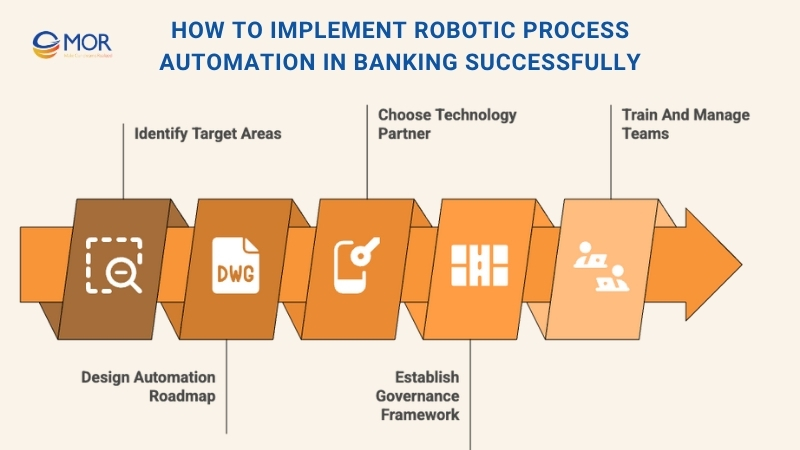
To begin, banks should conduct a detailed review to pinpoint high-volume, rule-based activities that would benefit most from automation. Once identified, teams can create an automation roadmap that defines goals, expected outcomes, and measurable milestones. A Proof of Concept (PoC) phase can then help validate the business value and refine the deployment strategy.
For a smooth rollout of automation for banking, institutions can follow these key steps:
- Identify target areas – Focus on processes like reporting, KYC verification, and reconciliation that depend on structured data.
- Design a scalable automation roadmap – Outline timelines, compliance requirements, and integration priorities.
- Choose the right technology partner – Work with experienced providers who can ensure secure implementation and regulatory alignment.
- Establish governance and delivery frameworks – Build enterprise-wide monitoring systems and quality controls to maintain oversight.
- Train employees and manage change – Create internal training programs to promote collaboration between human teams and digital bots.
Following these steps, financial institutions can implement RPA automation in banking effectively, improve efficiency, and achieve sustainable transformation across their operations.
Future Trends In Robotic Process Automation For The Banking Industry
As digital transformation accelerates, robotic process automation in banking industry is evolving from rule-based task execution to intelligent, connected systems that learn and adapt. The future of automation in financial services will be defined by smarter tools, real-time insights, and greater collaboration between humans and machines.
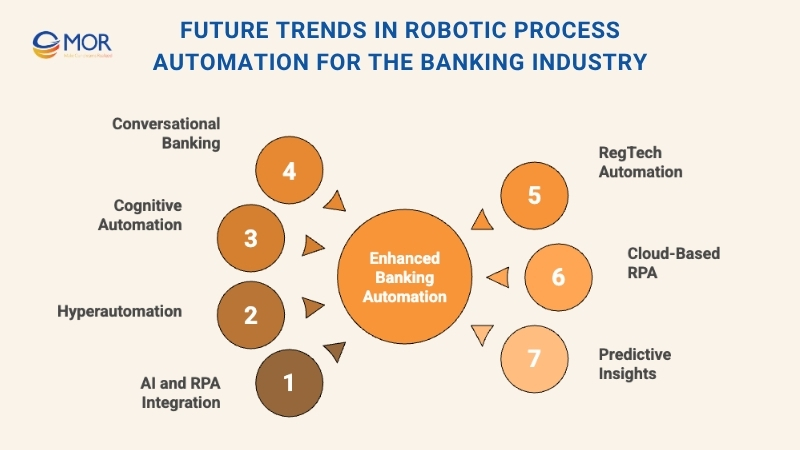
- AI and RPA Integration: The blend of RPA with artificial intelligence enables smarter decision-making for fraud prevention, credit evaluation, and compliance tracking. Bots can now analyze context and recommend actions, not just execute tasks.
- Hyperautomation: Combining RPA, AI, and machine learning using R, banks are moving toward end-to-end automation that connects departments and simplifies complex workflows.
- Cognitive Automation: Advances in natural language processing and machine learning allow bots to interpret emails, contracts, and even handwritten notes, improving data accuracy and operational speed.
- Conversational Banking: Integrating RPA with voice and chat technologies allows real-time interactions through virtual assistants, making customer service faster and more personalized.
- RegTech and Compliance Automation: Regulatory technology powered by robotic automation in financial services helps institutions stay compliant through continuous monitoring, reporting, and audit trail generation.
- Cloud-Based RPA Platforms: Banks are increasingly adopting cloud-hosted enterprise AI platforms for scalability, security, and quicker deployments across global branches.
- Predictive Insights with RPA: Using historical and live data, automation tools can anticipate market risks, detect anomalies, and guide better financial decisions.
Collectively, these innovations mark a shift toward an intelligent, adaptive ecosystem where robotic process automation in banking becomes the foundation for future-ready financial operations.
Implement Robotic Process Automation In Banking With MOR Software
At MOR Software, we help financial institutions implement robotic process automation in banking to simplify workflows, improve compliance, and cut operational costs. With experience from more than 850 projects across 10 countries, our machine learning engineers design automation systems that connect seamlessly with core banking platforms, whether on-premise or in the cloud.
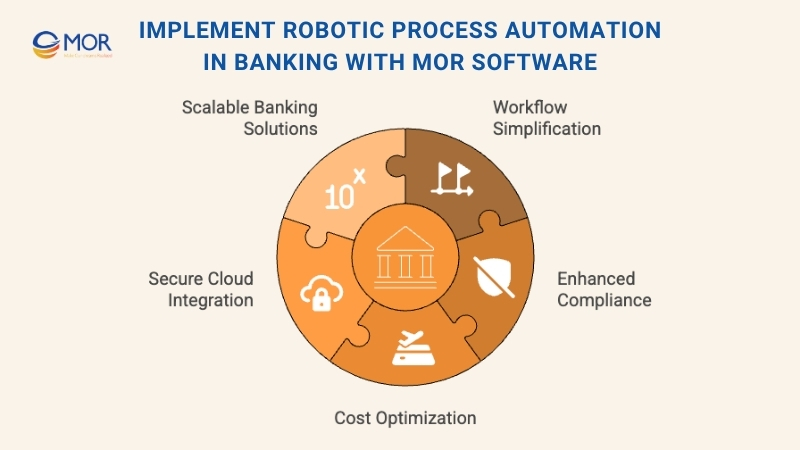
Using secure tools and Agile methods, we automate tasks like KYC, loan processing, and report generation with accuracy and speed. Partnering with MOR means gaining a trusted team that delivers scalable, compliant, and results-driven RPA solutions for lasting efficiency. Contact us today to start building your RPA roadmap and unlock smarter banking operations.
Conclusion
Robotic process automation in banking is redefining how financial institutions operate, helping them cut costs, eliminate errors, and deliver faster, more reliable services. As automation becomes the core of digital transformation, now is the time to take action. MOR Software combines technical expertise with proven industry experience to design scalable, secure, and high-performance RPA systems. Contact us today to discuss your automation goals and start building a smarter, more efficient future for your bank.
MOR SOFTWARE
Frequently Asked Questions (FAQs)
What is RPA in banking?
Robotic process automation in banking uses software bots to perform repetitive tasks like data entry, transaction updates, and report generation. These bots interact with existing systems and applications to help banks process large volumes of data faster and with fewer errors.
How does RPA improve banking operations?
RPA streamlines operations by automating routine processes such as account reconciliation, KYC verification, and loan processing. It reduces human error, cuts costs, and allows employees to focus on higher-value work like customer engagement and strategic planning.
What are the most common RPA use cases in banking?
Typical RPA applications include automating loan approvals, account openings, transaction monitoring, compliance reporting, and customer onboarding. These processes benefit from faster turnaround times and improved accuracy.
How does RPA ensure compliance in financial institutions?
Automation tools can create complete audit trails for each process, ensuring transparency and easier compliance with financial regulations. They also minimize manual data handling, which helps maintain data integrity and reduces compliance risk.
Can RPA handle customer service tasks in banking?
Yes. RPA bots can assist customer service teams by automating responses to common queries, updating customer records, and routing complex requests to human agents. This reduces waiting time and improves overall service quality.
What is the difference between RPA and AI in banking?
RPA focuses on rule-based, repetitive tasks, while AI adds intelligence through learning and pattern recognition. When combined, they enable smarter automation that can make predictions and handle complex decisions.
What is the future of RPA in banking?
The future of RPA is tied to artificial intelligence. Banks are moving toward intelligent automation that processes unstructured data, uses predictive analytics, and supports real-time decision-making for better risk management and customer experience.
What is process automation in banking?
Process automation in banking refers to using digital tools to replace manual, rule-driven workflows. It improves operational efficiency, boosts compliance, and ensures consistent service delivery across branches and channels.
What is an example of automated banking?
A common example is loan automation. RPA can collect applicant data, verify documents, perform credit checks, and generate approval decisions in minutes instead of days, speeding up the customer journey.
How can RPA benefit both customers and employees?
Customers experience faster service and fewer errors, while employees are freed from tedious work to focus on client relationships and innovation. This balance improves satisfaction on both sides and supports sustainable growth in banking.
Rate this article
0
over 5.0 based on 0 reviews
Your rating on this news:
Name
*Email
*Write your comment
*Send your comment
1